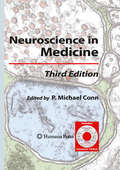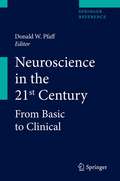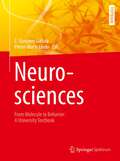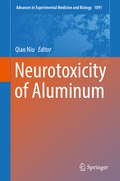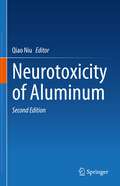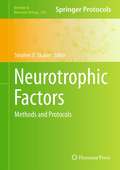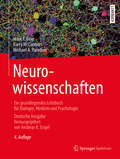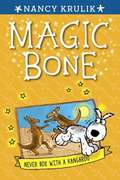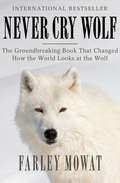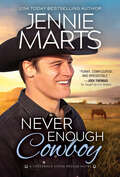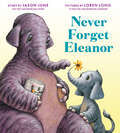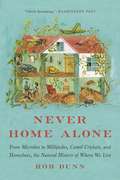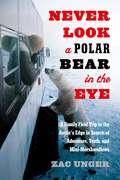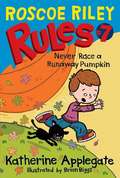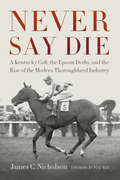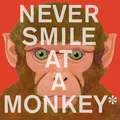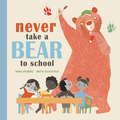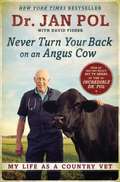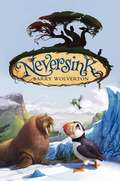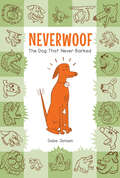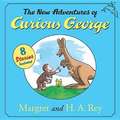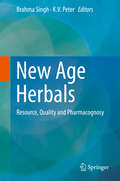- Table View
- List View
Neuroscience in Medicine
by P. Michael ConnContinuing progress has been made in understanding the brain at the molecular, anatomic, and physiological levels in the years following the "Decade of the Brain," with the results providing insight into the underlying basis of many neurological disease processes. In Neuroscience in Medicine, Third Edition, a distinguished panel of basic and clinical investigators, noted for their teaching excellence, provide thoroughly updated and revised chapters to reflect these remarkable advances. Designed specifically for medical students and allied health professionals, this up-to-date edition alternates scientific and clinical chapters that explain the basic science underlying neurological processes and then relate that science to the understanding of neurological disorders and their treatment. These popular and now expanded "clinical correlations" cover, in detail, disorders of the spinal cord, neuronal migration, the autonomic nervous system, the limbic system, ocular motility, and the basal ganglia, as well as demyelinating disorders, stroke, dementia and abnormalities of cognition, congenital chromosomal and genetic abnormalities, Parkinson's disease, nerve trauma, peripheral neuropathy, aphasias, sleep disorders and myasthenia gravis. In addition to concise summaries of the most recent biochemical, physiological, anatomical, and behavioral advances, the chapters summarize current findings on neuronal gene expression and protein synthesis at the molecular level. Authoritative and comprehensive, Neuroscience in Medicine, Third Edition provides a fully up-to-date and readily accessible guide to brain functions at the cellular and molecular level, as well as clearly demonstrating their emerging diagnostic and therapeutic importance.
Neuroscience in the 21st Century
by Donald W. PfaffEdited and authored by a wealth of international experts in neuroscience and related disciplines, the aim behind this key new resource is to offer medical students and graduate researchers around the world a comprehensive introduction and overview of modern neuroscience. Neuroscience research is certain to prove a vital element in combating mental illness in its various incarnations, a strategic battleground in the future of medicine, as the prevalence of mental disorders is becoming better understood each year. Hundreds of millions of people worldwide are affected by mental, behavioral, neurological and substance use disorders. The World Health Organization estimated in 2002 that 154 million people globally suffer from depression and 25 million people from schizophrenia; 91 million people are affected by alcohol use disorders and 15 million by drug use disorders. A more recent WHO report shows that 50 million people suffer from epilepsy and 24 million from Alzheimer's and other dementias. Because neuroscience takes the etiology of disease--the complex interplay between biological, psychological, and sociocultural factors--as its object of inquiry, it is increasingly valuable in understanding an array of medical conditions. A recent report by the United States' Surgeon General cites several such diseases: schizophrenia, bipolar disorder, early-onset depression, autism, attention deficit/ hyperactivity disorder, anorexia nervosa, and panic disorder, among many others. Not only is this volume a boon to those wishing to understand the future of neuroscience, it also aims to encourage the initiation of neuroscience programs in developing countries, featuring as it does an appendix full of advice on how to develop such programs. With broad coverage of both basic science and clinical issues, comprising 106 chapters from a diversity of international authors and including complementary video components, Neuroscience in the 21st Century will serve as a comprehensive resource to students and researchers alike.
Neurosciences - From Molecule to Behavior: a university textbook
by C. Giovanni Galizia Pierre-Marie LledoNeurosciences - a comprehensive approach This textbook covers neuroscience from cellular and molecular mechanisms to behavior and cognitive processing. We also address evolution of the nervous system, computational neuroscience, the history of neuroscience as a discipline and neurophilosophy - to name but a few. The book provides the newest state-of-the-art knowledge about neuroscience from across the animal kingdom, with particular emphasis on model species commonly used in neuroscience labs across the world: mouse, zebra fish, fruit fly, honeybee, and nematode worm. We aim at university students of neuroscience, psychology, biological sciences, and medical sciences, but also computer scientists, philosophers, or anybody interested in understanding how brains work.
Neurotoxicity of Aluminum (Advances in Experimental Medicine and Biology #1091)
by Qiao NiuThis book reviews the scientific literature and the authors’ own research linking aluminum neurotoxicity with cognitive impairment and Alzheimer’s disease (AD). It focuses on aluminum levels in the brain, region-specific and subcellular distribution, and its relation to neurofibrillary tangles and amyloid beta. Further, the book stresses the importance of aluminum’s complex speciation chemistry in relation to biology, and details aluminum’s mechanism in oxidative stress and cell death, especially in connection with apoptosis and necroptosis. The electrophysiological variation and synaptic plasticity induced by aluminum are covered, while the metal’s debatable role in AD and the cross-talk between aluminum and genetic susceptibility are also discussed. In closing, the book reviews the neurotoxic effects of aluminum and its important role in the pathogenesis of AD. Given its depth of coverage, the book provides readers with a systematic summary of aluminum neurotoxicity.
Neurotoxicity of Aluminum
by Qiao NiuThis book reviews the scientific literature and the authors’ own research linking aluminum neurotoxicity with cognitive impairment and Alzheimer’s disease (AD). It focuses on aluminum levels in the brain, region-specific and subcellular distribution, its relation to neurofibrillary tangles and amyloid beta—the pathological features of AD, and the possible mechanism of aluminum inducing these pathological features. Further, the book stresses the importance of aluminum’s complex speciation chemistry in relation to biology, and details aluminum’s mechanism in oxidative stress and cell death, especially in connection with apoptosis and necroptosis. The electrophysiological variation and synaptic plasticity induced by aluminum are covered, while the metal’s debatable role in AD and the cross-talk between aluminum and genetic susceptibility are also discussed, and more recently the relationship between aluminum-induced epigenetic modification on DNA and non-coding RNAs and neuron death and synaptic impairment.The second edition updates eight chapters according to the most recent researches. Content about aluminum-induced AD-like pathological features, neurotoxic effects of aluminum and aluminum alloy nanoparticles(TBD) and alumina nanoparticles induced neurotoxic and neurodevelopmental toxic effects is also added. In closing, this book provides readers with a systematic summary of aluminum neurotoxicity.
Neurotrophic Factors
by Stephen D SkaperNervous system development evolves from the well-orchestrated processes of neural induction, cell proliferation, differentiation, cell migration, survival, and synapse formation. Among these environmental cues, neurotrophic factors are secreted proteins that promote neurite outgrowth, neuronal cell differentiation and survival both in vivo and in vitro. Nerve growth factor (NGF) is the founding and best characterized member of the neurotrophin family of neurotrophic polypeptides. Neurotrophic Factors: Methods and Protocols presents a selection of protocols and procedures which make use of cellular, tissue, and whole animal models which can be applied to the investigation of neurotrophic factors and other agents impacting on these systems. Chapters cover a wide-range of topics such as dealing with the culture of neurons and glia from the central and peripheral nervous systems, neuron-glia co-culture models, and cell-based assays for the evaluation of neuroprotective molecules, as well as assays which can be applied to the study of agents with neuroregenerative potential. Protocols describing viral- and nanoparticle-based delivery methods to neural cells are also presented, following by chapters dealing with organotypic slice culture protocols. Lastly, several chapters are dedicated to in vivo lesion models of relevance to nervous system pathology, which can be applied to the investigation of neurotrophic factors and peptides. Written in the successful Methods in Molecular BiologyTM series format, chapters include introductions to their respective topics, lists of the necessary materials and reagents, step-by-step, readily reproducible protocols, and notes on troubleshooting and avoiding known pitfalls. Authoritative and easily accessible, Neurotrophic Factors: Methods and Protocols seeks to serve both professionals and novices alike with its well-honed methodologies in an effort to further our knowledge of what has been described as the last frontier of science.
Neurowissenschaften: Ein Grundlegendes Lehrbuch Für Biologie, Medizin Und Psychologie
by Monika Niehaus-Osterloh Andreas Held Andreas K. Engel Michael A. Paradiso Barry W. Connors Mark F. BearDer perfekte Einstieg in die Neurowissenschaften – ideal zum Verstehen und LernenSeit vielen Jahren zählt diese didaktisch durchdachte, verständlich geschriebene und hervorragend illustrierte Einführung international zu den führenden Lehrbüchern im Bereich der Neurowissenschaften. Das moderne Grundlagenwerk richtet sich an Studierende der Biologie, der Medizin und der Psychologie gleichermaßen. Die wieder von Andreas Engel herausgegebene deutsche Ausgabe ist an die hiesige Studiensituation angepasst und stellenweise erweitert. Der Bogen spannt sich von der Anatomie des Gehirns bis zur Sinnesphysiologie, von der Entwicklungsbiologie bis zum Verhalten, von den Störungen des Nervensystems bis zur Kognitionswissenschaft, von den molekularen Mechanismen bis zu den neuen bildgebenden Verfahren. Ein eigenständiger „Bildatlas der menschlichen Neuroanatomie“ erlaubt dem Lernenden, seine Kenntnisse der Hirnstrukturen zu überprüfen und zu erweitern. Jedes Kapitel endet mit Verständnisfragen und Übungsaufgaben sowie einer Zusammenstellung wichtiger weiterführender Literatur. In spannenden Exkursen berichten renommierte Wissenschaftler, wie sie zu ihren entscheidenden Entdeckungen kamen. So führt das Buch den Leser von den Grundlagen zu den aktuellen Forschungsthemen des Faches.In der durchgehend aktualisierten 4. Auflage sind unter anderem neue Forschungsergebnisse zu Optogenetik, Konnektomik, tiefer Hirnstimulation, molekularer Medizin und Neuroökonomie eingearbeitet worden. Zahlreiche neue oder aktualisierte Abbildungen veranschaulichen in bewährter Manier die im Text beschriebenen Prozesse, Strukturen und Methoden. Wer Neurowissenschaften in ihrer ganzen Bandbreite verstehen will, ist mit "dem Bear" bestens bedient. Den drei Verfassern des Buches gelingt, womit Lehrbuchautoren im deutschsprachigen Raum sich nach wie vor schwer tun: anschaulich und spannend den Leser vom Einstieg in die Grundlagen bis an die vorderste Front der Forschung mitzunehmen und ohne überflüssigen Ballast wissenschaftliche Erkenntnis mehr erzählend als erklärend zu vermitteln … Ein didaktisches Meisterwerk ist nun topaktuell auch in deutscher Sprache neu aufgelegt verfügbar. Aus dem Vorwort von Prof. Andreas K. Engel, Universitätsklinikum Hamburg-Eppendorf
Never Box with a Kangaroo #11
by Nancy Krulik Sebastien BraunSparky goes down under!When Sparky chomps on his magic bone, this time it kabooms him to Kangaroo Island, Australia! There he discovers a fox terrier puppy named Mick who's lost his family. But Sparky has a plan--he'll help Mick find a new family! They ask everyone they come across: bats, penguins, kangaroos, even bees! But will anyone give Mick a home?
Never Cry Wolf: Penguin Modern Classics Edition (Hrw Library)
by Farley MowatThe bestselling nature classic that stands as a hallmark of conservation writing and forever changed the way we look at wolves In 1948, Farley Mowat landed in the far north of Manitoba, Canada, a young biologist sent to investigate the region's dwindling population of caribou. Many people thought that the caribous' conspicuous decline had been caused by the tundra's most notorious predator: the wolf. Alone among the howling canine packs, Mowat expected to find the bloodthirsty beasts of popular conception. Instead, over the course of a summer spent observing the powerful animals, Mowat discovered an animal species with a remarkable capacity for loyalty, virtue, and playfulness. Praised for its humor and engrossing narrative, Never Cry Wolf describes a group of wolves whose interactions and behaviors seem strikingly similar to our own. Mowat humanizes these animals that have long been demonized, turning the widespread narrative of the "savage wolf" on its head and inspiring many governments to enact protective legislation for the North's most mysterious creature.
Never Enough Cowboy (Creedence Horse Rescue #4)
by Jennie Marts"A swoon-worthy, must-read romance."?SARA RICHARDSON, National bestselling authorFans of Carolyn Brown, Maisey Yates, and Jennifer Ryan will fall head over cowboy boots for this second-chance romance from USA Today bestseller Jennie Marts.Single mom Jillian Bennett barely has a moment to herself between raising her ten-year old son, volunteering at the horse rescue ranch, and working her new job as head librarian of Creedence, Colorado. She doesn't have time for romance either, even though she and the cute deputy, Ethan Rayburn, have been doing a lot of flirting the last few weeks. But when he also forms a bond with her son, Milo, Jillian falls hard, and Ethan soon realizes he would do anything for the feisty librarian who's won his heart."Full of hope, humor, and undeniable swoon."?A.J. PINE, USA Today bestselling author, for How to Cowboy"Funny, complicated, and irresistible."?JODI THOMAS, New York Times bestselling author, for Caught Up in a Cowboy"Deliciously steamy but still sweet."?JOANNE KENNEDY for Wish Upon a Cowboy
Never Forget Eleanor
by Jason JuneThis poignant story from New York Times bestselling author Jason June and #1 New York Times bestselling illustrator Loren Long reminds us of the life-changing power of words and the ways we remember the ones we love who've been affected by Alzheimer's or dementia. Perfect for fans of Drawn Together and The Rough Patch. Elijah loves spending time with his grandma Eleanor. She knows all the best words to answer tricky crossword puzzles and to tell the most beautiful stories to her family and friends.Everyone calls her “Never Forget Eleanor” because she remembers every word she reads and person she meets. Lately though, Elijah has started to notice Grandma Eleanor forgetting little things.So when Grandma Eleanor doesn’t show up for her Saturday story session, Elijah will need to find a way to use her favorite words and become the storyteller himself to bring her home.
Never Home Alone: From Microbes to Millipedes, Camel Crickets, and Honeybees, the Natural History of Where We Live
by Rob DunnA natural history of the wilderness in our homes, from the microbes in our showers to the crickets in our basements <P><P>Even when the floors are sparkling clean and the house seems silent, our domestic domain is wild beyond imagination. In Never Home Alone, biologist Rob Dunn introduces us to the nearly 200,000 species living with us in our own homes, from the Egyptian meal moths in our cupboards and camel crickets in our basements to the lactobacillus lounging on our kitchen counters. You are not alone. <P><P>Yet, as we obsess over sterilizing our homes and separating our spaces from nature, we are unwittingly cultivating an entirely new playground for evolution. These changes are reshaping the organisms that live with us--prompting some to become more dangerous, while undermining those species that benefit our bodies or help us keep more threatening organisms at bay. <P><P>No one who reads this engrossing, revelatory book will look at their homes in the same way again.
Never Look a Polar Bear in the Eye: A Family Field Trip to the Arctic's Edge in Search of Adventure, Truth, and Mini-Marshmallows
by Zac Unger"I like to go out for walks, but it's a little awkward to push the baby stroller and carry a shotgun at the same time."--housewife from Churchill, Manitoba Yes, welcome to Churchill, Manitoba. Year-round human population: 943. Yet despite the isolation and the searing cold here at the arctic's edge, visitors from around the globe flock to the town every fall, driven by a single purpose: to see polar bears in the wild.Churchill is "The Polar Bear Capital of the World," and for one unforgettable "bear season," Zac Unger, his wife, and his three children moved from Oakland, California, to make it their temporary home. But they soon discovered that it's really the polar bears who are at home in Churchill, roaming past the coffee shop on the main drag, peering into garbage cans, languorously scratching their backs against fence posts and front doorways. Where kids in other towns receive admonitions about talking to strangers, Churchill schoolchildren get "Let's All Be Bear Aware" booklets to bring home. (Lesson number 8: Never explore bad-smelling areas.)Zac Unger takes readers on a spirited and often wildly funny journey to a place as unique as it is remote, a place where natives, tourists, scientists, conservationists, and the most ferocious predators on the planet converge. In the process he becomes embroiled in the controversy surrounding "polar bear science"--and finds out that some of what we've been led to believe about the bears' imminent extinction may not be quite the case. But mostly what he learns is about human behavior in extreme situations . . . and also why you should never even think of looking a polar bear in the eye.
Never Race a Runaway Pumpkin (Roscoe Riley Rules #7)
by Katherine ApplegateRoscoe is determined to guess the weight of a giant pumpkin in order to win books for his school library and candy for himself, but is overwhelmed by superstitions, especially about a certain black kitten.
Never Say Die: A Kentucky Colt, the Epsom Derby, and the Rise of the Modern Thoroughbred Industry
by James C. NicholsonA history of the American horse that won Britain’s greatest race and changed the Thoroughbred racing world.A quarter of a million people braved miserable conditions at Epsom Downs on June 2, 1954, to see the 175th running of the prestigious Derby Stakes. Queen Elizabeth II and Sir Winston Churchill were in attendance, along with thousands of Britons who were all convinced of the unfailing superiority of English bloodstock and eager to see a British colt take the victory. They were shocked when a Kentucky-born chestnut named Never Say Die galloped to a two-length triumph at odds of 33–1, winning Britain’s greatest race and beginning an important shift in the world of Thoroughbred racing.Never Say Die traces the history of this extraordinary colt, beginning with his foaling in Lexington, Kentucky, as well as the stories of the influential individuals brought together by the horse and his victory?from the heir to the Singer sewing machine fortune to the Aga Khan. Most fascinating is the tale of Mona Best of Liverpool, England, whose well-placed bet on the long-shot Derby contender allowed her to open the Casbah Coffee Club. There, her son met musicians John Lennon, Paul McCartney, and George Harrison, later joining their band.Featuring a foreword by the original drummer for the Beatles, Pete Best, this remarkable book reveals how an underdog’s surprise victory played a part in the formation of the most successful and influential rock band in history and made the Bluegrass region of Kentucky the center of the international Thoroughbred industry.Praise for Never Say Die“Nicholson has done a very fine job of placing the unique role of Never Say Die in perspective within the specific confines of Thoroughbred racing history, while at the same time explaining how this horse was touched by a vivid array of characters in other social and historical contexts. Who would have imagined that a racehorse would link such diverse institutions as the Singer sewing machine company, the Epsom Derby, and the Beatles?” —Edward L. Bowen, author of The Lucky Thirteen“As a reader, I was left with a clear understanding of how the breeding industry has gone global, and importantly, how it will always follow the money. Racing enthusiasts will enjoy how the author sews together this unusual patchwork of characters into a narrative.” —John Eisenberg, author of The Great Match Race: When North Met South in America’s First Sports Spectacle“[E]nlightening and entertaining. . .Nicholson’s tale of close connections and global links is a yarn worth following.” —Wall Street Journal
Never Smile at a Monkey: And 17 Other Important Things to Remember
by Steve JenkinsWhen it comes to wild animals, everyone knows that there are certain things that one should not do. In this fascinating picture book, readers find out what they should "never" do if they encounter one of these surprisingly dangerous animals.
Never Take a Bear to School
by Mark SperringA delightfully funny story that will reassure every child anxious about starting a new school or nursery.Bears are clumsy. They don't sit still. They're much, much bigger than teachers - and they eat SUCH a lot of lunch! Yes, taking a bear to school is a BAD idea. But will this little boy find the courage to face the first day of school alone?With so much to do, like painting, dressing up, storytime, and making new friends, he just might! And Bear? He'll always be waiting at the end of the day, with a great big hug!
Never Tease a Weasel
by Jean Conder SouleReading this book together is an excellent and fun way to learn about teasing. " You can knit a kitten mittens And perhaps that cat would purr. You could fit a fox with socks That exactly matched his fur. ... But never tease a weasel; This is very good advice. A weasel will not like it And teasing isn't nice!" This file should make an excellent embossed braille copy.
Never Turn Your Back on an Angus Cow
by David Fisher Dr Jan PolThe star of The Incredible Dr. Pol shares his amusing, and often poignant, tales from his four decades as a vet in rural Michigan. Dr. Jan Pol is not your typical veterinarian. Born and raised the Netherlands on a dairy farm, he is the star of Nat Geo Wild's hit show The Incredible Dr. Pol and has been treating animals in rural Michigan since the 1970s. Dr. Pol's more than 20,000 patients have ranged from white mice to 2600-pound horses and everything in between. From the time he was twelve years old and helped deliver a litter of piglets on his family's farm to the incredible moments captured on his hit TV show, Dr. Pol has amassed a wealth of stories of what it's like caring for this menagerie of animals. He shares his own story of growing up surrounded by animals, training to be a vet in the Netherlands, and moving to Michigan to open his first practice in a pre fab house. He has established himself as an empathetic yet no-nonsense vet who isn't afraid to make the difficult decisions in order to do what's best for his patients--and their hard-working owners. A sick pet can bring heartache, but a sick cow or horse could threaten the very livelihood of a farmer whose modest profits are dependent on healthy livestock.Reminiscent of the classic books of James Herriot, Never Turn Your Back on an Angus Cow is a charming, fascinating, and funny memoir that will delight animal lovers everywhere.
Never Turn Your Back on an Angus Cow
by Dr Jan Pol David FisherThe star of The Incredible Dr. Pol shares his amusing, and often poignant, tales from his four decades as a vet in rural Michigan. Dr. Jan Pol is not your typical veterinarian. Born and raised the in Netherlands on a dairy farm, he is the star of Nat Geo Wild's hit show The Incredible Dr. Pol and has been treating animals in rural Michigan since the 1970s. Dr. Pol's more than 20,000 patients have ranged from white mice to 2600-pound horses and everything in between. From the time he was twelve years old and helped deliver a litter of piglets on his family's farm to the incredible moments captured on his hit TV show, Dr. Pol has amassed a wealth of stories of what it's like caring for this menagerie of animals. He shares his own story of growing up surrounded by animals, training to be a vet in the Netherlands, and moving to Michigan to open his first practice in a pre fab house. He has established himself as an empathetic yet no-nonsense vet who isn't afraid to make the difficult decisions in order to do what's best for his patients--and their hard-working owners. A sick pet can bring heartache, but a sick cow or horse could threaten the very livelihood of a farmer whose modest profits are dependent on healthy livestock. Reminiscent of the classic books of James Herriot, Never Turn Your Back on an Angus Cow is a charming, fascinating, and funny memoir that will delight animal lovers everywhere.
Neversink
by Barry Wolverton Sam NielsonAlong the Arctic Circle lies a small island called Neversink, whose jagged cliffs and ice-gouged rocks are home to a colony of odd-looking seabirds called auks, including one Lockley J. Puffin. With their oceanfront views and plentiful supply of fish, the auks have few concerns--few, save for Lockley's two best friends, Egbert and Ruby, a know-it-all walrus and a sharp-tongued hummingbird. But all of this is about to change. Rozbell, the newly crowned king of the Owl Parliament, is dealing with a famine on the mainland of Tytonia--and he has long had his scheming eyes on the small colony to the north. Now Neversink's independence hangs in the balance. An insurgence of owls will inevitably destroy life as the auks know it--unless Lockley can do something about it. Barry Wolverton's debut is an epic tale of some very un-epic birds, a fast-paced and funny story of survival, friendship, and fish.
Neverwoof
by Gabe JensenIn retro pantone style, a hilarious picture book about a dog who never barks. But what will he do when a burglar threatens his home?
The New Adventures of Curious George
by Margret ReyThis collection includes eight full-length stories including Curious George Goes to a Chocolate Factory, Curious George and the Puppies, Curious George Makes Pancakes, Curious George Feeds the Animals, Curious George Goes to a Movie, Curious George and the Hot Air Balloon, Curious George in the Snow, and Curious George’s Dream.
New Age Herbals: Resource, Quality And Pharmacognosy
by Brahma Singh K. V. PeterImportance of herbs (medicinal plants) can hardly be overemphasized. They are exploited for manyfold applications, ranging from phytopharmaceuticals, to nutraceuticals, to cosmetics and many others. Keeping in view the richness of herbs and their vast potential, this book collates the most up-to-date knowledge of important herbs and herbals. The book also gives an overview of some issues causing hindrance in the promotion of herbals. This book attempts to compile the rich experience of experts working on various herbs. New age single plant species, having multiple medicinal traits worth exploiting i.e. Hippophae rhamnoides (seabuckthorn), and Morinda citrifolia (noni) also find place as full chapters in the book.
